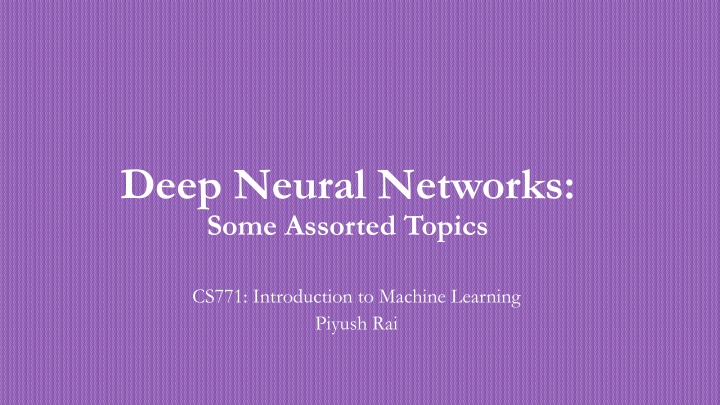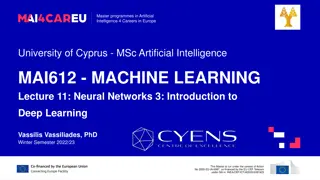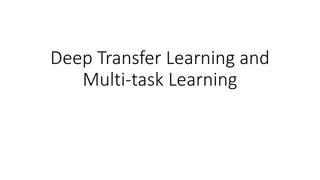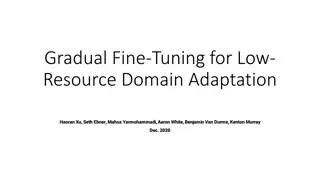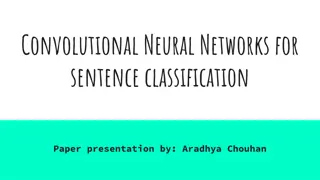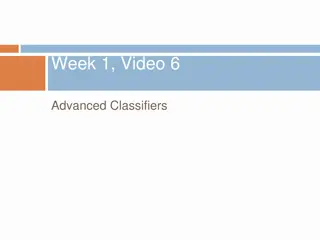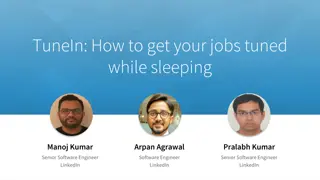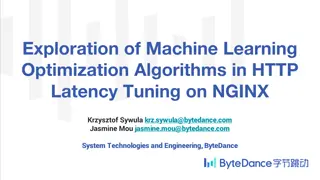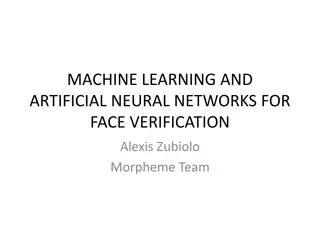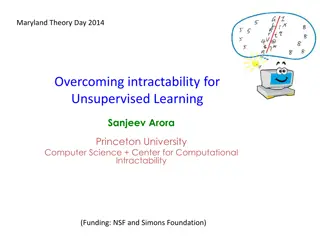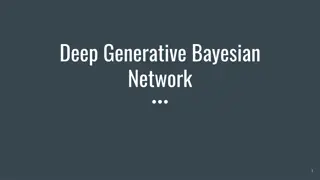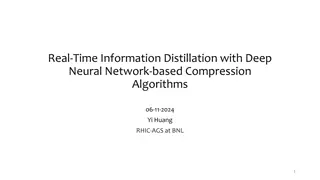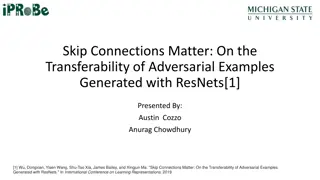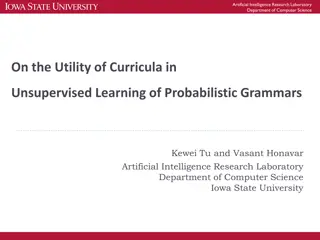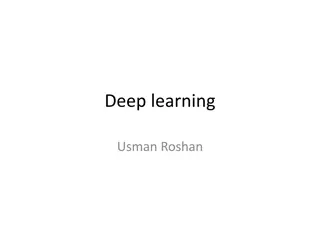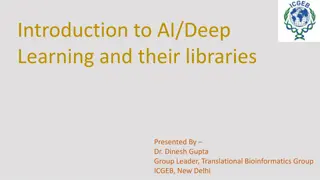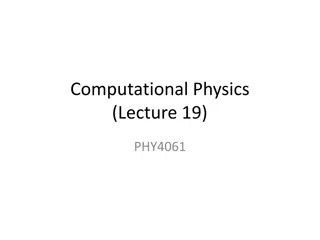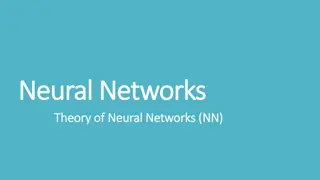Deep Neural Networks: Fine-Tuning and Unsupervised Learning
"Explore the concepts of fine-tuning and unsupervised pre-training in deep neural networks, along with the use of auto-encoders for unsupervised feature learning. Learn how models like BERT and GPT are pre-trained using self-supervised learning for further task-specific fine-tuning."
Download Presentation

Please find below an Image/Link to download the presentation.
The content on the website is provided AS IS for your information and personal use only. It may not be sold, licensed, or shared on other websites without obtaining consent from the author.If you encounter any issues during the download, it is possible that the publisher has removed the file from their server.
You are allowed to download the files provided on this website for personal or commercial use, subject to the condition that they are used lawfully. All files are the property of their respective owners.
The content on the website is provided AS IS for your information and personal use only. It may not be sold, licensed, or shared on other websites without obtaining consent from the author.
E N D
Presentation Transcript
Deep Neural Networks: Some Assorted Topics CS771: Introduction to Machine Learning Piyush Rai
2 Fine-tuning and Transfer Learning Deep neural networks trained on one dataset can be reused for another dataset It is like transferring the knowledge of one learning task to another learning task This is typically done by freezing most of the lower layers and finetuning the output layer (or the top few layers) this is known as fine-tuning BERT (pre-trained in unsupervised manner) fine-tuned for a sentence classification task by adding a fully connect MLP to predict class-label of a sentence Initial model with frozen layers is called the pre- trained model and the updated model is called the fine-tuned model This example is for an MLP like architecture but fine-tuning can be done for other architectures as well, such as RNN, CNN, transformers, etc Figure source: Dive into Deep Learning (Zhang et al, 2023) CS771: Intro to ML
3 Unsupervised Pre-training Self-supervised learning is a powerful idea to learn good representations unsupervisedly Self-supervised learning will help us learn a good encoder (feature representation) Hide part of the input and predict it using the remaining parts Self-supervised learning is key to unsupervised pre-training of deep learning models Such pre-trained models can be fine-tuned for any new task given labelled data Models like BERT, GPT are usually pre-trained using self-supervised learning Then we can finetune them further for a given task using labelled data for that task CS771: Intro to ML
A special type of self-supervised learning: The whole input is being predicted by first compressing it and then uncompressing 4 Auto-encoders Auto-encoders (AE) are used for unsupervised feature learning Consist of an encoder ? and a decoder ? ? and ? can be deep neural networks (MLP, RNN, CNN, etc) VAE can also generate synthetic data usings its decoder (standard AE s decoder can t generate new data) Note: Usually only the encoder is of use after the AE has been trained (unless we want to use the decoder for reconstructing the inputs later) If using a prior on ?, we can a probabilistic latent variable model called variational auto-encoder (VAE) ? = ?(? ? ) Goal: Learn ? and ? s.t. ? ? is small ? = ?(?) Dimensionality of ? can be chosen to be smaller or larger than that of ? In such cases, need to impose additional constraints on ? so that we don t learn an identify mapping from ? to ? Sometimes we want to learn overcomplete feature representations of the input If using AE for dimensionality reduction ? ? CS771: Intro to ML
5 Convolution-less Models for Images: MLP-mixer Many MLPs can be mixed to construct more powerful deep models ( MLP-mixer ) T T stands for Transpose CS771: Intro to ML MLP-Mixer: An all-MLP Architecture for Vision (Tolstikhin et al, 2021)
6 Or triplets (e.g., cat is more similar to dog than to a table ) Contrastive Learning Can learn good features by comparing/ contrasting similar and dissimilar object pairs Such pairs can be provided by to the algorithm (as supervision), or the algorithm can generate such pairs by itself using data augmentation (as shown in example below) The embeddings for non-match pairs must be far away ( repel ) from each other The corresponding embeddings for such pairs must be close ( attract ) to each other Distance metric learning by learning ? given similar/dissimilar pairs ?(?? ??) ? ??,?? = ?? ?? Augmentation by cropping and resizing. The class of the image remains unchanged in this augmentation Such contrastive learning of features is also related to distance metric learning algos CS771: Intro to ML
7 Zero-Shot Learning and CLIP What if our training data doesn t have the test data classes? Several methods to solve ZSL using deep learning. CLIP is a recent approach CLIP: Contrastive Language-Image Pre-training (Radford et al, 2021) List of all possible objects that an image could be about Suppose, at test time, we want our predicted labels to be of the form a photo of a {object} Suppose our training data contains image-caption pairs Learn the text and image encoders such that the embeddings of the image and its corresponding text have high similarity CS771: Intro to ML
8 Bias-Variance Trade-off Assume to be a class of models (e.g., linear classifiers with some pre-defined features) Suppose we ve learned a model ? learned using some (finite amount of) training data We can decompose the test error ?(?) of ? as follows E.g., going from linear models to deep nets or by adding more features Reason: We are now learning a more complex model using the same amount of training data Can bias reduce by making class richer Making richer will also cause estimation error to increase Here ? is the best possible model in assuming infinite amount of training data Approximation error: Error of ? because of model class being too simple Also known as bias (high if the model is simple) Estimation error: Error of ? (relative to ? ) because we only had finite training data Also known as variance (high if the model is complex) Because we can t keep both low, this is known as the bias-variance trade-off CS771: Intro to ML
9 Bias-Variance Trade-off Bias-variance trade-off implies how training/test losses vary as we increase model complexity CS771: Intro to ML
10 Deep Neural Nets and Bias-Variance Trade-off Bias-variance trade-off doesn t explain well why deep neural networks work so well They have very large model complexity (massive number of parameters massively overparametrized ) Despite being massively overparametrized, deep neural nets still work well because Implicit regularization: SGD has noise (randomly chosen minibatches) which performs regularization These networks have many local minima and all of them are roughly equally good SGD on overparametrized models usually converges to flat minima (less chance of overfitting) Such minima are not good because they might represent an overfitted solution Such a solution is less likely to be an overfitted solution because other nearby solutions are also reasonably good A flat minima A sharp minima SGD because of the noise can escape such sharp minima Learning of good features from the raw data Ensemble-like effect (a deep neural net is akin to an ensemble of many simpler models) Trained on very large datasets CS771: Intro to ML
11 Double Descent Phenomenon Overparametrized deep neural networks exhibit a double descent phenomenon Bias-variance trade-off seen only in the underparametrized regime Beyond a point (in the overparametrized regime), the test error starts decreasing once again even as the model gets more and more complex CS771: Intro to ML Figure source: A Farewell to the Bias-Variance Tradeoff? An Overview of the Theory of Overparameterized Machine Learning (Dar et al, 2021)
12 Deep Neural Networks: A Summary CS771: Intro to ML
13 Common Types of Layers used in Deep Learning Linear layer: Have the form ? ? (used in fully connected networks like MLP and also in some parts of other type of models like CNN, RNN, transformers, etc) Nonlinearity: Activation functions (sigmoid, tanh, ReLU, etc) Essential for any deep neural network (without them, deep nets can t learn nonlinear functions) Convolutional layer: Have the form ? ? (here * denotes the conv operation) Usually used in conjunction with pooling layers (e.g., max pooling, average pooling) Residual or skip connections: Help when learning very deep networks (e.g., ResNets, transformers, etc) by avoiding vanishing/exploding gradients Normalization layer such as batch normalization and layer normalization Dropout layer: Helps to regularize the network Recurrent layer: Used in sequential data models such as RNNs and variants Attention layer: Used in encoder-decoder models like transformers (also in some RNN variants) Multiplicative layer: Have the form ? ?? (used when each input has two parts ? and ?) CS771: Intro to ML
14 Popular Deep Learning Architectures MLP: Feedforward fully connected network Not preferred when inputs have spatial/sequential structures (e.g., image, text) Some variants of MLP (e.g., MLP-mix) perform very well on such data as well CNN: Feedforward but NOT fully connected (but last few layers, especially output, are) RNNs: Not feedforward (hidden state of one timestep connects with that of the next) Transformers: Very powerful models for sequential data Unlike RNNs, can process inputs in parallel. Also uses (self) attention to better capture long range dependencies and context in the input sequence Graph Neural Networks: Used when inputs are graphs (e.g., molecules) Autoencoders and Deep Generative Models: For unsupervised representation learning and synthetic data generation tasks CS771: Intro to ML
